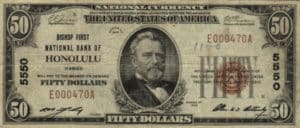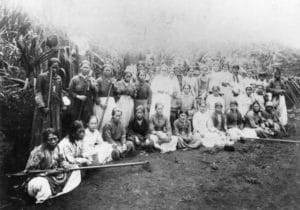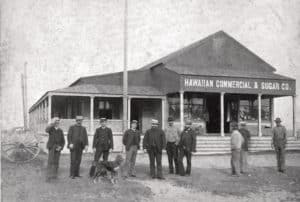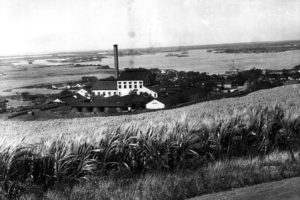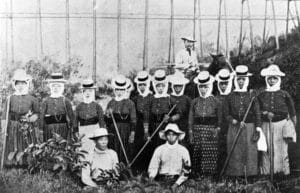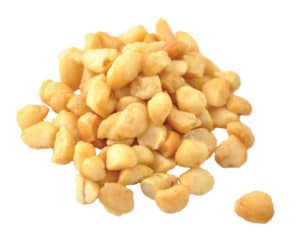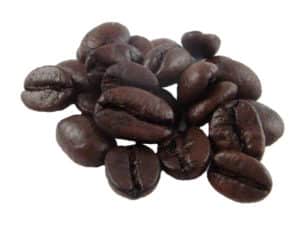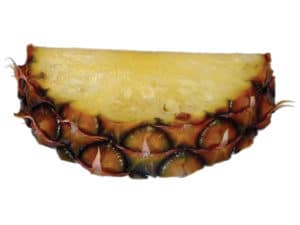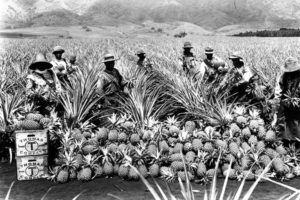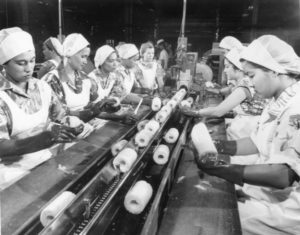Early 1900s Industry Shifts
Back in 1835, three men from New England had leased a 980-acre tract at Kōloa on Kaua‘i from Kamehameha III to be used for a sugarcane plantation. Soon after, stone mills appeared on Maui, Hawai‘i, and O‘ahu. After several booms resulted from the California Gold Rush of 1849 and the end of the Civil War, new improved mills appeared and sugar became big business. By the early 1900s, the profitability of sugar drew the attention of five companies who would come to be known as the “Big Five”: Alexander & Baldwin, C. Brewer, Castle & Cooke, Theo H. Davies, and American Factors. They produced over ninety-five percent of Hawai‘i’s sugar.
Annexation to the United States did make plantation workers freer to act to improve their conditions. The Organic Act of 1900, which set up laws for the Territory, forbade contract labor; right away there were work stoppages and strikes. In 1909, the largest strike so far in Hawai‘i took place. It was called by Japanese workers on an O‘ahu plantation, and it lasted for three months. Meanwhile, plantations continued to grow in size and number. The demand for workers grew. Puerto Rican laborers arrived in 1900, Koreans in 1903, and Filipinos in 1906. After the 1909 strike, planters again tried to bring in European workers. In 1920, the longest strike ever to take place in the Territory broke out. It was also important because, for the first time, more than one national group of laborers joined together, first Filipinos, then Japanese. They worked together successfully for the common good of all plantation workers and were able to win benefits such as better working and living conditions and higher wages.
The Great Depression in the 1930s affected Hawai‘i, just as it did mainland America. Foreign workers could not be brought in as easily, so plantations had to depend on the local labor force. Great improvements were made in working conditions on the plantations to keep the workers. From 1935 to 1941, there was great union activity and a shortage of skilled labor. Wages rose on the plantations and in the trades and crafts. By 1941 there were twenty-nine local unions with eight thousand members.
The first commercial macadamia nut growing venture was started in 1934 by a man named Earnest Van Tassel. Chocolate covered macadamia nuts were soon to follow through companies called Ellen Dye Candies and the Alexander Young Hotel candy shop. In 1939, Hawaiian Candies & Nuts, Ltd. originated the “Menehune Mac” candy that is still enjoyed around the world today.
In the early 1800s, coffee had been introduced to the islands as it was brought from Brazil. Chief Boki, the royal governor of the island of O‘ahu at that time, was responsible for having the first coffee trees planted in Mānoa Valley. Then, by the 1930s, there were about one thousand coffee-growing farms.
Hawai‘i’s pineapple industry also grew between the wars. For a long time pineapple had grown wild in Hawai‘i’s warm, moist climate. People thought of the scratchy little plants as weeds, and the fruit was small and bitter. It was not until the late 1800s that Captain John Kidwell, a plant expert, brought in a better kind of pineapple. It was known as the “Smooth Cayenne.” This was to be the variety grown in the islands.
From a one-man operation in 1901, the pineapple business grew a thousand fold to become the Territory’s second most important industry up until the mid-1940s. Hawai‘i’s pioneer in pineapple production was James D. Dole, who formed the Hawaiian Pineapple Company in 1901. In 1922, the company bought the island of Lāna‘i for large-scale production. Unlike sugarcane, it needed little water, no irrigation. Harvest time was usually June through September.
By the 1920s, the Big Five knew they could no longer ignore pineapples, so they started companies, too. The industry became centered on five islands—O‘ahu, Lāna‘i, Kaua‘i, Maui, and Moloka‘i. Nine companies operated thirteen plantations and nine canneries. Castle & Cooke finally forced Dole out in 1948, although the cans and labels still have his name. Hawai‘i used to produce seven-hundred-million cans of pineapple a year. Today there are no canneries in Hawai‘i.
